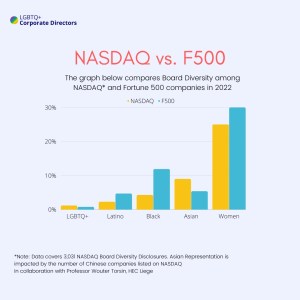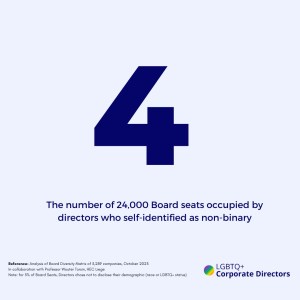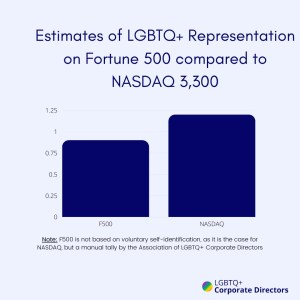A ground-breaking study provides new data about diversity on the boards of directors of 3,031 companies (representing 2,503 U.S. and 528 foreign firms) listed on the NASDAQ stock exchange.
The demographic information in the study is based on voluntary self-identification by each member of a company’s board. Notably, about 5 percent of board members did not disclose demographic information, and 3 percent did not reveal their gender, an option provided by the NASDAQ Board diversity matrix instructions.
While the study focused on LGBTQ+ representation, which accounts for 1.2 percent of all board seats, it painted a depressing picture of overall diversity on NASDAQ-listed U.S. companies’ boards. Women held only 25 percent of board seats, African Americans 4.3 percent, Asian/Pacific Islander 9 percent, Hispanic/Latino 2.3 percent, and Native Americans 1 percent. An additional 1.41 percent of directors in the U.S. self-identified as bi-racial. In comparison, women held more than 30 percent of Fortune 500 board seats, African Americans 11.9 percent, Asian/Pacific Islander board members 5.4 percent, Hispanic/Latino 4.7 percent, and LGBTQ+ people 0.8 percent. Explanations for these significant differences may be that NASDAQ-listed companies tend to be younger, smaller, and more concentrated in technology, and Fortune 500 companies are under greater scrutiny.
The study’s main conclusion, as it relates to sexual orientation, is that 292 seats, or 1.3 percent, were occupied by self-identified LGBTQ+ people in 2022. The geographical disparities were significant; while this number reached 1.3 percent for U.S.-incorporated companies (representing 260 seats) and 1.4 percent for European ones, only 0.8 percent of foreign firms had an LGBTQ+ director. Two hundred sixty-three companies had one LGBTQ+ board member, 12 had two, and two had three, for a total of 278 companies, or 9 percent of the NASDAQ. As for gender identity, only two seats were occupied by self-identified non-binary people. A list of these 280 companies is provided here.
Life sciences companies had the highest percentage of LGBTQ+-occupied board seats in the U.S. (1.8percent), followed by business equipment companies (1.29 percent). Manufacturing (0.26 percent), chemical (0.46 percent), and utility (0.46 percent) companies were the least likely to have an LGBTQ+ board member.
This new data creates a benchmark for future studies. Its findings echo the Association of LGBTQ+ Directors’ previous Fortune 500 analysis (not based on voluntary disclosure but a manual tally by the association), which revealed that LGBTQ+ people occupy about 40 seats (or 0.8 percent in 38 companies representing 7.6 percent of the Fortune 500), showcasing underrepresentation of LGBTQ+ people who comprise 7.2 percent of the U.S. population.
Reasons for this underrepresentation were outlined in the association’s 2023 LGBTQ+ Board Monitor Report, available here. The association’s extensive network of LGBTQ+ talent demonstrates that there is a substantial pool of qualified individuals. Yet, the exclusion of LGBTQ+ directors has persisted for too long and is unacceptable in 21st-century America.
This post comes to us from Fabrice Houdart, the founder and executive director of the Association of LGBTQ+ Corporate Directors and an adjunct professor at Georgetown University and Columbia University. It is based on a recent study, available here, by the association and Professor Wouter Torsin at HEC Management School, University of Liege.
 Sky Blog
Sky Blog




